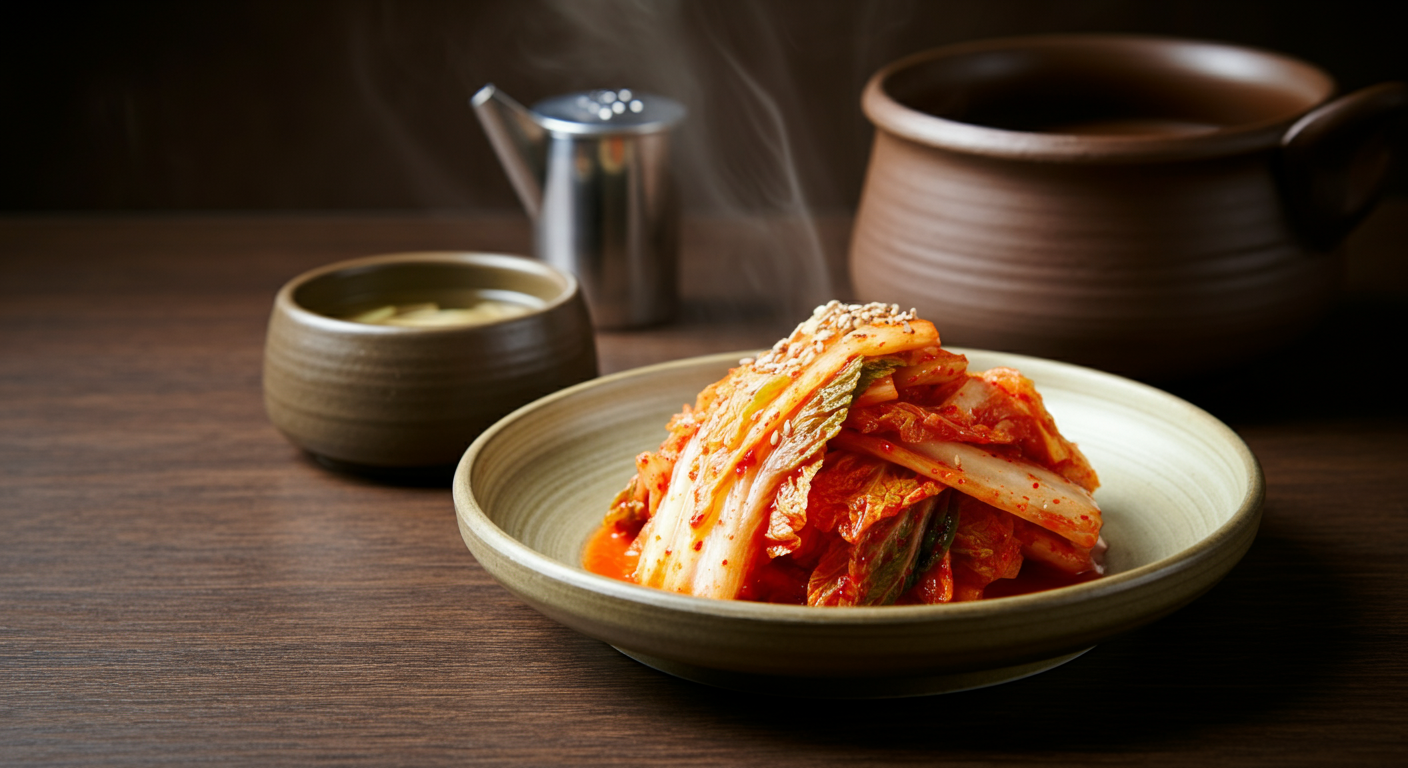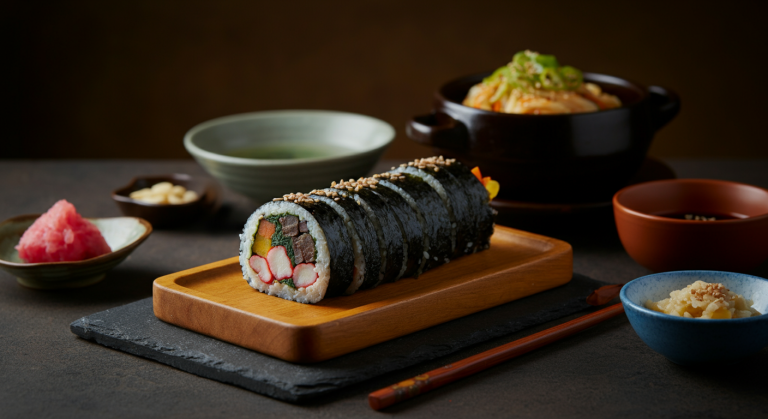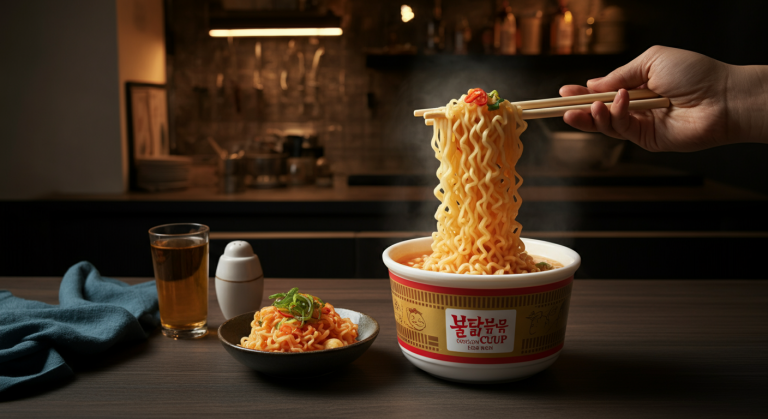Kimchi: First Impressions & Fun Stories

Get ready, K-drama addicts and K-pop stans! Today, we’re diving deep into the vibrant, spicy, and utterly essential world of Kimchi (김치). If you’ve ever watched a Korean show, you’ve seen it; if you’ve ever tried Korean food, you’ve tasted it; and if you’ve ever found yourself utterly captivated by Korean culture, you know it’s everywhere. But what *is* Kimchi (김치), really? It’s more than just a side dish; it’s a fermented symphony of flavors, a culinary cornerstone, and a symbol of Korean heritage that tells a story with every fiery bite.
For many international foodies, the first encounter with Kimchi (김치) can be a wild ride. Trust me, I’ve seen it countless times! Picture this: you’re at a Korean BBQ, the grill is sizzling, the air is thick with delicious anticipation, and then a small, crimson dish arrives. It looks innocent enough, a vibrant mix of cabbage and spices. You take a cautious bite, and *wham!* A spicy, tangy, complex flavor explodes in your mouth. Your eyes might widen, your nose might tingle, and you might even wonder, “What on earth just happened?” This initial shock, this spicy wake-up call, is often followed by a fascinating transformation: curiosity, then appreciation, and finally, a deep, undeniable craving. It’s like falling in love with a K-drama’s second lead – unexpected, intense, and utterly unforgettable. Many start with a “Wow, that’s intense!” and soon find themselves saying, “Daebak! (대박! – amazing/awesome) I need more Kimchi (김치)!” This journey from startled first impression to utter adoration is a classic rite of passage for anyone embracing Korean cuisine. Growing up, I remember my foreign friends trying it for the first time, their faces a mix of surprise and delight, often exclaiming, “It’s so… fresh and spicy!” and then, inevitably, reaching for another piece. It’s a testament to Kimchi’s (김치) unique charm.
Kimchi: The Cultural Foundation of Korean Cuisine (김치)
At its heart, Kimchi (김치) is a traditional fermented vegetable dish, most commonly made with napa cabbage, Korean radish, or cucumbers, seasoned with a vibrant mix of chili powder (고춧가루), garlic, ginger, scallions, and various seafood extracts. It’s deeply ingrained in the Korean psyche, embodying not just food, but history, community, and resilience. For Koreans, a meal without Kimchi (김치) feels incomplete, like a K-drama without a dramatic plot twist. It’s an automatic side dish (반찬) in every single meal, from a humble breakfast to a celebratory feast. This cultural omnipresence is what makes Kimchi (김치) so much more than just fermented cabbage; it’s a testament to Korean identity.
The Kimchi First Impression: A Spicy Wake-Up Call (첫인상)
So, let’s talk about that initial encounter, shall we? You’ve seen your favorite K-drama characters slurp down a bowl of ramyun (라면) with a perfect, glistening piece of Kimchi (김치) on the side, or enjoy a hearty bowl of Kimchi jjigae (김치찌개) with friends. It looks delicious, right? And it is! But the first taste often carries a delightful punch. The spice, often a robust and lingering heat from the gochugaru (고춧가루), combined with the pungent garlic and the unique tang of fermentation, can be quite startling. It’s an acquired taste for some, but trust me, once acquired, it’s addictive. That burst of flavor, that unexpected kick, is part of Kimchi’s (김치) charm. It’s assertive, confident, and unapologetically Korean. Think of it like the initial “hate-to-love” trope in K-dramas; you might be taken aback at first, but soon you’re completely smitten. My own family jokes about how foreigners first react – a dramatic gasp, a sip of water, and then a slow, thoughtful nod as the flavors start to make sense. That’s the moment the Kimchi (김치) spell begins to work its magic.
The Art of Kimjang (김장): Community and Connection
Beyond its taste, Kimchi (김치) carries profound social meaning, particularly through the tradition of *Kimjang* (김장). This isn’t just about making food; it’s an annual ritual of community and shared labor, where families and neighbors gather to make large quantities of Kimchi (김치) for the winter months. Imagine a vibrant scene, much like those heartwarming family gatherings in K-dramas, with women (and sometimes men!) bustling about, laughing, gossiping, and meticulously salting cabbages and mixing seasoning. It’s an expression of *jeong* (정), a deep sense of affection, attachment, and human connection that Koreans cherish. This collective effort ensures that everyone has enough Kimchi (김치) to last through the cold season, fostering a profound sense of unity and mutual support. In 2013, UNESCO recognized Kimjang as an Intangible Cultural Heritage of Humanity, acknowledging its vital role in reinforcing community bonds and cultural identity. Learn more about Kimjang on UNESCO’s website. It’s a beautiful tradition that transcends simple food preparation.
Kimchi’s Evolution: From Ancient Fermentation to K-Culture Icon
The history of Kimchi (김치) stretches back thousands of years. Early forms involved simple salt-fermented vegetables to preserve them during harsh winters. The vibrant red color we associate with Kimchi (김치) today only appeared after chili peppers were introduced to Korea in the 16th century. Before then, it was likely white or colorless! This evolution reflects Korea’s adaptability and culinary innovation. Today, Kimchi (김치) is a global ambassador for Korean food. From celebrity chefs incorporating it into fusion dishes to K-pop idols showcasing their favorite Kimchi (김치) brands on social media, it’s a truly modern icon. This ancient food has effortlessly transitioned into the digital age, proving its timeless appeal and universal deliciousness. It perfectly demonstrates how tradition and modernity can coexist and thrive in Korean culture.
The Diverse World of Kimchi Varieties (김치 종류)
While *baechu kimchi* (배추김치), made from napa cabbage, is arguably the most famous and widely consumed type, the world of Kimchi (김치) is incredibly diverse. There are literally hundreds of varieties, each with its own unique flavor profile, ingredients, and regional significance. Exploring these different types is like discovering a new K-pop genre – each offers a fresh perspective and a new favorite to fall in love with. From watery, refreshing styles to crisp, spicy options, the range of Kimchi (김치) is truly astounding, reflecting Korea’s rich agricultural landscape and regional culinary traditions. This incredible diversity means that there’s always a Kimchi (김치) to suit every palate and every dish, making it a truly versatile food.
Beyond Baechu Kimchi (배추김치): A Symphony of Flavors
Beyond the familiar red cabbage, you’ll find an array of other delicious Kimchi (김치) types. There’s *kkakdugi* (깍두기), cubed radish Kimchi (김치), known for its satisfying crunch and slightly sweeter, milder flavor. Or *oisobagi* (오이소박이), a refreshing stuffed cucumber Kimchi (김치), perfect for hot summer days, often filled with chives and thinly sliced carrots. For those who prefer less spice, *baek kimchi* (백김치), or “white Kimchi,” offers a clean, crisp, and slightly sweet taste without the chili powder, often incorporating fruits like Asian pear. Each type presents a different texture and flavor experience, demonstrating the depth of Korean fermenting traditions. You might even find yourself developing a subtle *nunchi* (눈치 – the ability to understand unspoken cues/situations) for which Kimchi (김치) pairs best with which meal!
Seasonal Kimchi (계절 김치): Eating with Nature’s Rhythm
Koreans have a deep connection to nature, and this is beautifully reflected in their seasonal approach to food, including Kimchi (김치). Different vegetables are harvested and transformed into Kimchi (김치) throughout the year, celebrating the abundance of each season. Spring might bring *buchu kimchi* (부추김치), or chive Kimchi (김치), offering a pungent and fresh kick. Summer is perfect for lighter, more refreshing options like *yeolmu kimchi* (열무김치), young radish Kimchi (김치), often served with cold noodles. Autumn, of course, culminates in the grand Kimjang (김장) for the winter’s *baechu kimchi* (배추김치). This seasonal rotation isn’t just about freshness; it’s about living in harmony with the environment and savoring the unique gifts each part of the year brings. It’s a culinary calendar, ensuring a fresh and varied supply of delicious Kimchi (김치) all year round.
Kimchi in K-Dramas: Food for the Soul and the Plot
For K-drama fans, Kimchi (김치) isn’t just food; it’s a character, a plot device, and a symbol. How many times have we seen a character’s true personality revealed by their Kimchi (김치) preferences, or a heartwarming scene revolve around sharing a meal with homemade Kimchi (김치)? It represents comfort, home, and the unwavering love of a mother or grandmother. Think of the intense cravings for Kimchi jjigae (김치찌개) after a long day, or the satisfying crunch of Kimchi (김치) alongside a comforting bowl of ramyun (라면) in a cozy cafe. It’s often shown as the ultimate comfort food, a source of strength, or even a symbol of reconciliation. When characters share Kimchi (김치), they’re sharing more than just food; they’re sharing a piece of their lives and their hearts. It’s a true staple of K-drama culture, woven into the fabric of daily life and dramatic storytelling alike.
Kimchi’s Health Benefits and Global Impact (김치)
Beyond its incredible flavor and cultural significance, Kimchi (김치) is also celebrated for its impressive health benefits. It’s truly a superfood, packed with nutrients and probiotics, which have only added to its global appeal. As Korean culture, or *Hallyu* (한류), continues its meteoric rise around the world, Kimchi (김치) has naturally followed, becoming a beloved staple in kitchens far beyond Korea’s borders. It’s fascinating to see how this traditional fermented dish has transcended its origins to become a global culinary sensation, proving that good food, like good entertainment, knows no boundaries. This journey from a local tradition to an international health food is a remarkable testament to Kimchi’s (김치) power.
The Power of Fermentation: Kimchi as a Superfood
One of Kimchi’s (김치) most significant aspects is its fermentation process. This process creates beneficial bacteria, known as probiotics, which are fantastic for gut health. A healthy gut contributes to better digestion, a stronger immune system, and even improved mood – truly *daebak* (대박)! Kimchi (김치) is also low in calories and rich in vitamins A, B, and C, as well as essential minerals like calcium and iron. It’s no wonder that during the SARS and H1N1 outbreaks, there were anecdotal reports (and some studies) suggesting that Kimchi (김치) consumption might boost immunity. This combination of robust flavor and impressive health benefits makes Kimchi (김치) a winner on all fronts. For more scientific insights into Kimchi, you can check out its Wikipedia page. It’s more than just a tasty condiment; it’s a powerhouse of nutrition.
Kimchi and Hallyu (한류): A Taste of Korea Abroad
The global phenomenon of *Hallyu* (한류), or the Korean Wave, has been instrumental in introducing Kimchi (김치) to the world. As K-dramas captivate audiences with their compelling stories and K-pop groups dominate music charts with their electrifying performances, people become curious about all aspects of Korean culture, especially its food. When fans see their favorite idols enjoying Kimchi (김치), or when it’s prominently featured in a dramatic K-drama scene, it sparks a desire to try it themselves. This organic cultural spread has led to Kimchi (김치) finding its way into supermarkets, restaurants, and home kitchens across continents. It’s a wonderful example of how cultural exchange can enrich lives and palates worldwide. The accessibility of Kimchi (김치) in the global market today is largely due to the widespread popularity of Korean entertainment.
How to Enjoy Kimchi: Pairing Like a Pro
So, how should you enjoy your Kimchi (김치)? The beauty is in its versatility!
* **With Rice:** A classic pairing, a warm bowl of freshly cooked rice (밥) and a piece of Kimchi (김치) is simple perfection.
* **As a Side Dish (반찬):** Serve it with almost any Korean meal – BBQ, stews, noodles, you name it. It cuts through richness and adds a refreshing tang.
* **In Stir-fries:** Add it to fried rice (볶음밥), ramen (라면), or even pasta for a spicy, umami kick.
* **Kimchi Jjigae (김치찌개):** This hearty, spicy, and deeply satisfying stew made with aged Kimchi (김치), pork, and tofu is a must-try. Its rich, savory broth and the delightful tang of the fermented Kimchi (김치) are incredibly comforting.
* **With Korean BBQ:** The sour and spicy notes of Kimchi (김치) perfectly complement grilled meats, making every bite truly *masitda* (맛있다 – delicious)!
* **With Chicken and Beer (치킨과맥주):** Yes, even with fried chicken! A little bit of crunchy, spicy Kimchi (김치) can balance out the richness of fried chicken, and a cold beer (맥주) is always a good idea. This is a beloved combination in Korea, often seen in K-dramas during casual outings.
The possibilities are endless, and discovering your favorite Kimchi (김치) pairing is part of the fun. Don’t be afraid to experiment!
In conclusion, **Kimchi (김치)** is far more than just fermented cabbage. It’s a vibrant expression of Korean identity, a testament to community spirit through traditions like *Kimjang* (김장), a superfood packed with health benefits, and a delicious gateway to Korean culture for millions around the globe. From that initial, sometimes startling, first bite to the moment you find yourself craving its spicy tang, Kimchi (김치) has a way of captivating hearts and palates. It embodies the resilience, warmth, and rich flavors that define Korean cuisine and culture. So, whether you’re a seasoned Korean food lover or just beginning your journey, I hope this deep dive into Kimchi (김치) has piqued your interest and inspired you to embrace this incredible dish. Give it a try, experiment with different types, and let its unique charm captivate you. Who knows, you might just find your new favorite food – or perhaps, your new obsession. *Geureogeyo* (그러게요 – I know, right?), what are you waiting for? Let the Kimchi (김치) journey begin!


![Dear Mom, I Can’t Come to Dinner Because Baek Sa-eon Just [SPOILER] and I Need 3-5 Business Days to Recover](https://k-vibe.net/wp-content/uploads/2025/08/kvibe-thumbnail-20250829-215006-768x419.png)


